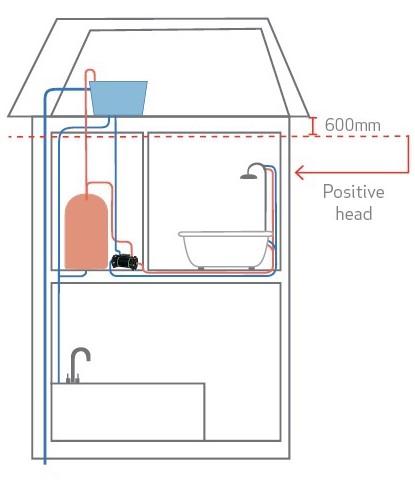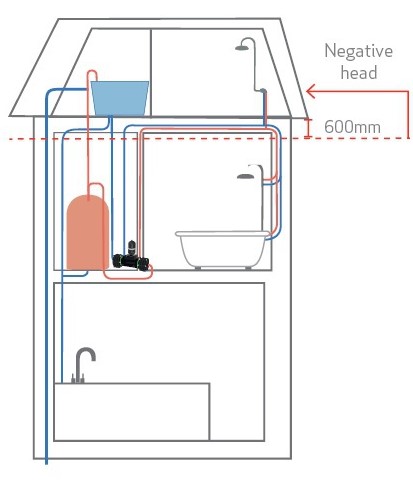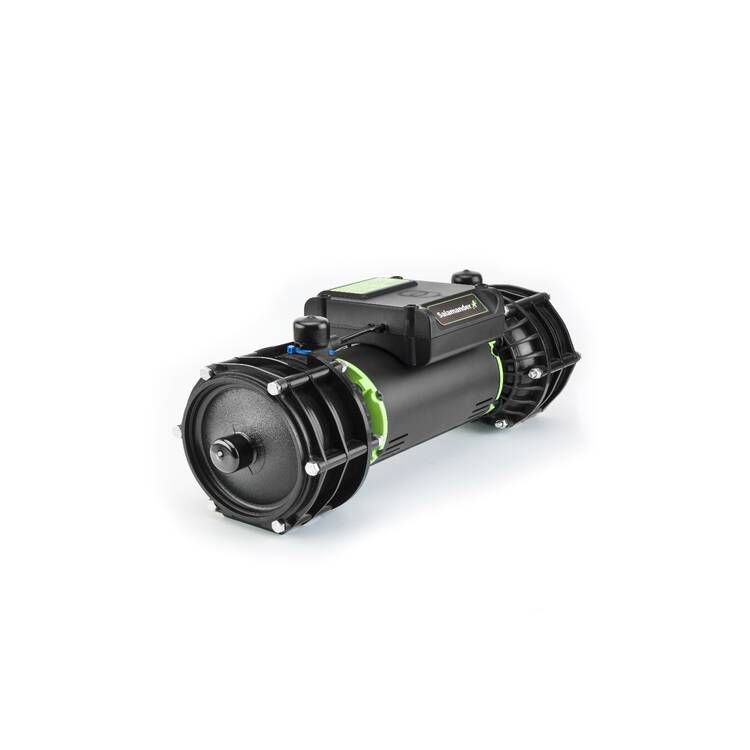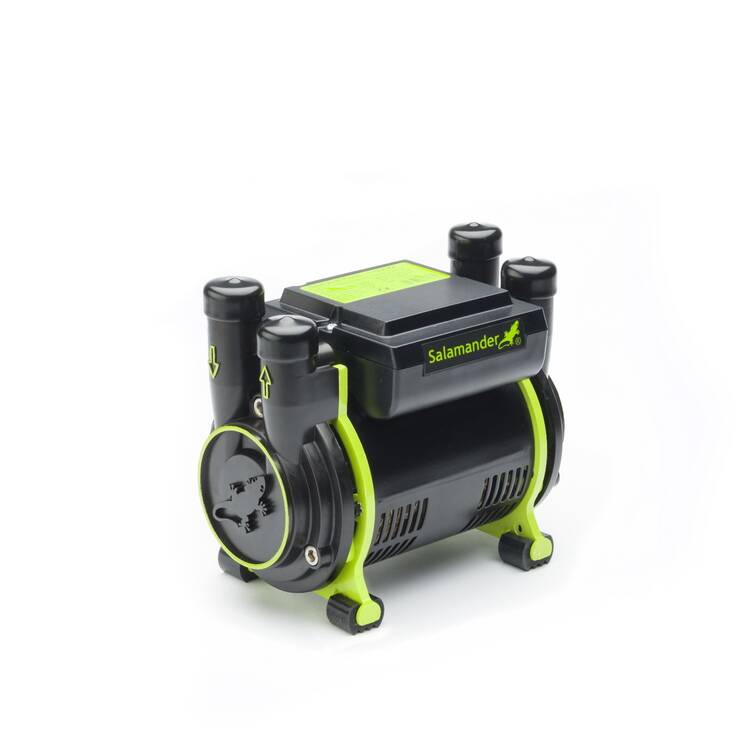If the water in your taps or shower has reduced to a trickle, it might be time to supercharge your water supply with a shower booster pump. Keep reading, and we'll show you how to decide if it's the right solution for your home. Then, we'll share our top tips for whittling down your search.
How do I know if I need a shower pump?
We all have a tap or shower in our home, and we assume is performing to its best ability. But if you add another tap or upgrade your regular shower for a power shower, it might start to struggle
This could be due to several factors. But if you think it's a pressure-related problem, just try this simple test. All you need is a one-litre jug and a timer.
- 1. Take the jug and place it below your showerhead.
- 2. Set your phone or watch to timer mode.
- 3. Turn the tap on full and activate your timer simultaneously. When the jug is full, stop the timer.
- 4. Insert your time into the equation below to learn how many litres per minute your shower can process. As a rule, if the time is above seven seconds, you have a poor flow rate and probably need a water pump. If your time is below seven seconds, you don't need a pump, so you can stop reading (if you wish).
60 ÷ (insert your time here) = X litres per minute.
So, which pump type do I need?
From here on in, it’s worth finding a pen and paper to jot down some notes. We’re going to dive into several different subjects, and we’d hate for you to forget anything important.
When searching for a shower pressure booster, start by checking the type of water heating system installed in your home. While this may sound strange, each heating system will process and pressurise water differently. Take a look.
Combi boiler system
A combi boiler relies heavily on your local water authority for flow and pressure. This means, if your neighbours use lots of water at specific times of the day, you will have less available during these periods. It’s possible to boost your water supply with a shower pump. However, if you constantly suffer from pressure problems, it may be worth getting a new boiler.
Gravity-fed system
If you have a gravity-fed system, you’ll need to choose a positive head shower pump for water tanks that are arranged above your tap or shower. Or a negative head shower pump if placed above, level or below your water tank. We’ll go into more detail about this later, but if in doubt, opt for a negative head pump.

Gravity-fed system with positive shower pump.

Gravity-fed system with negative shower pump.
Unvented heating system
In an unvented system, hot water is stored inside a pressurised cylinder and released on demand. But for greater pressure, just switch to a pumped AccuBoost tank. We recommend a pumped model for water flow under 12 litres per minute or pressure below 2 bars. And an unpumped tank if pressure and flow are good, but the demand for water is greater than what is available, i.e. if several people shower simultaneously.
Next, you'll need to understand how much pressure (known as a 'bar') you need. We mentioned it above, so it's time to explain.
What bar shower pump do I need?
Water pumps for showers vary by brand, type, bar size and performance. This can feel quite overwhelming, so we find the best place to start is by choosing the right bar, or 'pressure'. One way of doing this is by counting the number of water sources (like taps and showers) in your home.
All pumps are listed with a pressure rating. The most common have 1 bar, 2 bar or 3 bar, but there are also between sizes like 1.5 and 1.8 bars. Plus larger 4 bar pumps.
As a rough rule of thumb:
1 bar shower pump
A 1 bar shower pump is perfect for a small flat or if you have one small shower or tap.
2 bar shower pump
A 2 bar shower pump is ideal for a small, two-bedroom home with a low-pressure shower.
3 bar shower pump
A 3 bar shower pump is best for three or four-bedroom homes where multiple water sources are used simultaneously. Or, if you wish to upgrade your shower to a power shower, then we’d recommend a 3 bar pump.
What size shower pump do I need?
After counting the water sources in your home, it’s easy to decide what size pump you need. Just choose between a single or twin impeller pump.
Single impeller shower pump
Also known as a single shower pump, a single impeller pump improves the water pressure in one feed – either hot or cold. It can also be used for mixed feeds but not simultaneously.
Twin impeller shower pump
Also known as a twin shower pump, a twin impeller pump improves the water pressure in multiple hot and cold feeds simultaneously. These are highly popular in most homes.
Then, you need to consider a regenerative or centrifugal shower pump.
Regenerative or centrifugal shower pump?
Regenerative shower pump
A regenerative shower pump is designed to eliminate air pockets within a body of water. It forces the pressurised water to flow in and out of the pump in the same direction as the impeller’s rotation. This movement draws more water into the pump and pushes it out at a greater force. Just so you know, these pumps are generally cheaper to buy and easier to install.
Centrifugal shower pump
If you’re looking for a quiet shower pump, take a look at our centrifugal shower pumps. These are highly efficient and use impellers to enhance the water pressure before ejecting it at high pressure. To reach an even greater water pressure, ask your plumber about possibly installing multiple impellers – this is known as a multistage centrifugal pump.

Centrifugal shower pump.

Regenerative shower pump.
Next, it’s time to think about positive and negative head shower pumps. Again, this sounds complicated, but it’s pretty straightforward.
Do I need a positive or negative head shower pump?
Positive head shower pump
A positive head shower pump, also known as a gravity-fed shower pump, is the most popular choice for homes. These are placed below a water tank, which has been installed at least 3 feet and 3 inches (990mm) above a showerhead. This is far enough for the water to gain momentum and deliver a powerful experience.
Negative head shower pump
A negative head pump, also known as a universal shower pump, is placed above or level with a water tank. They force the water upwards, which is ideal for loft conversions, apartments and flats. But that’s not all; a negative head pump can be used in place of a positive head pump – but not vice versa.
What about a quiet shower pump?
It's no secret that some shower pumps can generate a fair bit of noise while in action. After all, they're transforming a trickle of water into a tidal wave. But don't worry; quiet shower pumps do exist.
That said, if you have your eye on a different, slightly noisier pump, there are things you can do to reduce the sound.
- 1. Install your pump on a flat, level surface.
- 2. Fit a pump mat underneath to absorb the vibrations.
- 3. Install a flange. This will reduce the amount of air inside the water stream. The less air, the quieter it functions.
- 4. Remember to fit the pump's feet to absorb vibrations.
- 5. Keep AV hoses straight to eliminate unwanted strain or noise.
- 6. Secure all pipework to combat unnecessary movement.
- 7. If all else fails, purchase a noise reduction kit.
Top tips
Double-check your water capacity
Remember to check your current water capacity before choosing a pump. This won’t be a problem if you have a combi boiler, since it connects directly to the mains water. But if you have a small water storage tank, a powerful 3-bar pump will finish your supply in minutes, and cut your shower short. If that’s the case, you could either choose a less powerful pump, or upgrade your water tank.
Triple-check your pipes
Most pumps come with pipe connections that are 15mm and 22mm diameter, to help you match it to your plumbing. In the UK, the standard pipe size is 22mm, but old houses may have 15mm pipes. While in the Republic of Ireland, a standard pipe is 21mm, but houses may have 15mm or 22mm installed. It’s worth noting, some pumps only work with 15mm plumbing. And importantly, a 15mm pump should never be connected to a 22mm pipe.
And there you go. If you have any further questions, just call one of our experts on 0871 244 0935 and we'd be happy to help.




















